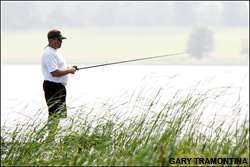
PLATTSBURGH, N.Y. — The arrival of autumn weather will dictate whether fishing at Lake Champlain will be average or exceptional during the B.A.S.S. Federation Nation Eastern Divisional Sept. 18 to 22.
However, even average fishing on Lake Champlain can be better than the action Eastern Divisional qualifiers experience on other fisheries throughout the region. "The quality of fish that come out of there is phenomenal," said Richard Petty, a part-time Lake Champlain guide. "I don't think you can go anywhere else in the United States and catch the quality fish that you can out of that lake."
Lake Champlain is one of the largest natural lakes in the country, extending 125 miles long and covering 271,000 acres. The northern half of the lake is smallmouth territory featuring clear water, rocky banks and shelves, islands and aquatic vegetation. "The northern end of the lake has tons of reefs," described Petty. "The smallmouth sit on those reefs where they feed all summer and get huge."
Clay banks tend to keep the waters dirtier on the southern half of the lake. "The water quality doesn't look great there, but it sure does produce a lot of big fish," said Petty. Largemouth bass thrive in the abundant wood, rocks and shallow milfoil on the lower end of Champlain.
Petty has noticed fishing for largemouth has improved recently as the water continues to clear. "We just got inundated with enormous amounts of rain this year and it really dirtied up the south end of the lake," he said. "Once that area gets muddied up, it takes forever to clear." The Adirondack Bass Club member predicts the lake level will be higher than normal during the divisional as a result of this spring's heavy rains.
Water temperature will be the key during this event. "If the water temperature drops below 70 degrees by that time, they could really have a heck of a tournament," claimed Petty. "If we get some really cool nights and the surface temperature comes down, just about any type of action bait will work really well." He predicts the water temperature might be in the low 70s when the Eastern Divisional competitors arrive.
Cooler weather will trigger the smallmouth into biting crawfish- or perch-colored medium or deep diving crankbaits or white and chartreuse 3/8-ounce spinnerbaits with gold or silver willowleaf blades. If the water temperature stays warm, the contenders will have to throw tube baits (watermelon or pumpkinseed) on 1/4- to 3/8-ounce jigheads, drop shots with black or watermelon finesse worms or black hair jigs with blue or purple plastic chunk trailers. The smallmouth will be on the reefs holding from 10 to 30 feet deep, depending on the water temperature.
Largemouth will be in a chasing mood during the divisional, Petty predicts. He suggests throwing a white crankbait, white or orange Rat-L-Traps, spinnerbaits or Zoom Flukes. Largemouth will be holding along the edge of the milfoil 4 to 5 feet deep. Petty warns that the contenders could lose some of their action baits on the south end because big northern pike also hit these lures.
Tournaments can be won on Lake Champlain with either bags of smallmouth or largemouth. "If you can get on the smallmouth you can really pull in some good weights," said Petty. "Twenty pounds of smallies isn't unheard of on this lake." Winning limits of largemouth frequently weigh 20 to 22 pounds.
The local guide believes the divisional winner will probably key on largemouth. "The smallmouth bite has been off this spring and summer," said Petty. "It just hasn't been like what it's been the in the past years." Denny Brauer proved how good the largemouth fishing is this year on Champlain when he won the Champions Choice Elite Series event in July by bringing in a four-day total of 20 bucketmouths weighing 80 pounds, 3 ounces, including a final-day catch of 23 pounds, 4 ounces.
Petty guesses it will take less weight to win the divisional, though. "If somebody can bring in an average of 18 pounds a day, they will probably finish in the top three," said Petty.





